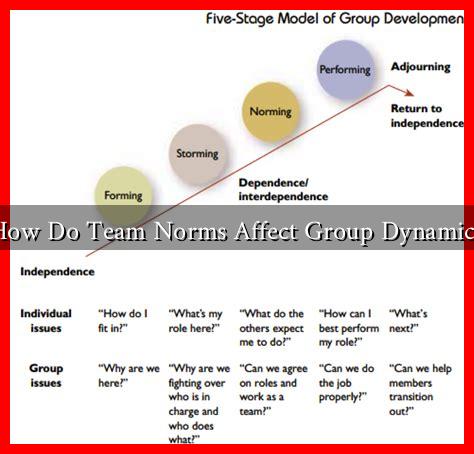-
Table of Contents
How Do Team Norms Affect Group Dynamics?
In any collaborative environment, the way a team operates is often dictated by a set of unwritten rules known as team norms. These norms can significantly influence group dynamics, shaping how members interact, communicate, and ultimately perform. Understanding the impact of team norms is crucial for leaders and team members alike, as it can lead to improved collaboration, productivity, and job satisfaction.
What Are Team Norms?
Team norms are the shared expectations and rules that guide behavior within a group. They can be explicit, such as formal policies, or implicit, arising from the team’s culture and interactions. Team norms can cover various aspects, including:
- Communication styles
- Decision-making processes
- Conflict resolution methods
- Work ethic and accountability
- Inclusivity and respect for diversity
These norms can evolve over time and are often influenced by the team’s leadership, the organization’s culture, and the individual personalities of team members.
The Role of Team Norms in Group Dynamics
Team norms play a pivotal role in shaping group dynamics, which refers to the behavioral and psychological processes that occur within a social group. Here are several ways in which team norms affect group dynamics:
1. Establishing Trust and Safety
When team norms promote open communication and respect, they create an environment of trust. Team members feel safe to express their ideas and concerns without fear of judgment. For instance, a study published in the Journal of Business Research found that teams with high levels of psychological safety were more innovative and effective in problem-solving.
2. Enhancing Collaboration
Norms that encourage collaboration can lead to more effective teamwork. When team members understand their roles and responsibilities and are encouraged to share knowledge, the group can leverage diverse skills and perspectives. For example, in a software development team, norms that promote pair programming and code reviews can enhance the quality of the final product.
3. Influencing Conflict Resolution
Conflict is inevitable in any team setting. However, the way conflicts are managed can vary significantly based on team norms. Teams that have established norms for constructive feedback and conflict resolution tend to navigate disagreements more effectively. For instance, a case study on a healthcare team showed that implementing structured conflict resolution norms led to a 30% reduction in unresolved conflicts, improving overall team morale.
4. Shaping Performance and Accountability
Team norms also influence how members hold each other accountable. Norms that emphasize accountability can lead to higher performance levels. For example, a sales team that has a norm of weekly performance check-ins is likely to achieve better results than one that does not prioritize accountability. According to a report by the Gallup Organization, teams with high accountability are 50% more likely to achieve their goals.
Case Studies: The Impact of Team Norms
Several organizations have successfully harnessed the power of team norms to enhance group dynamics:
- Google: The tech giant’s Project Aristotle revealed that psychological safety was the most important factor in team effectiveness. Teams that fostered open communication and trust outperformed others.
- Pixar: The animation studio encourages a culture of feedback, where team members regularly share constructive criticism. This norm has led to higher creativity and innovation in their films.
Conclusion
Team norms are a fundamental aspect of group dynamics that can significantly influence a team’s effectiveness and overall success. By establishing clear, positive norms around communication, collaboration, conflict resolution, and accountability, teams can create an environment that fosters trust, innovation, and high performance. As organizations continue to navigate the complexities of teamwork, understanding and actively shaping team norms will be essential for achieving collective goals and enhancing workplace satisfaction.
In summary, the impact of team norms on group dynamics cannot be overstated. Leaders and team members should prioritize the development of healthy norms to cultivate a productive and harmonious work environment.

